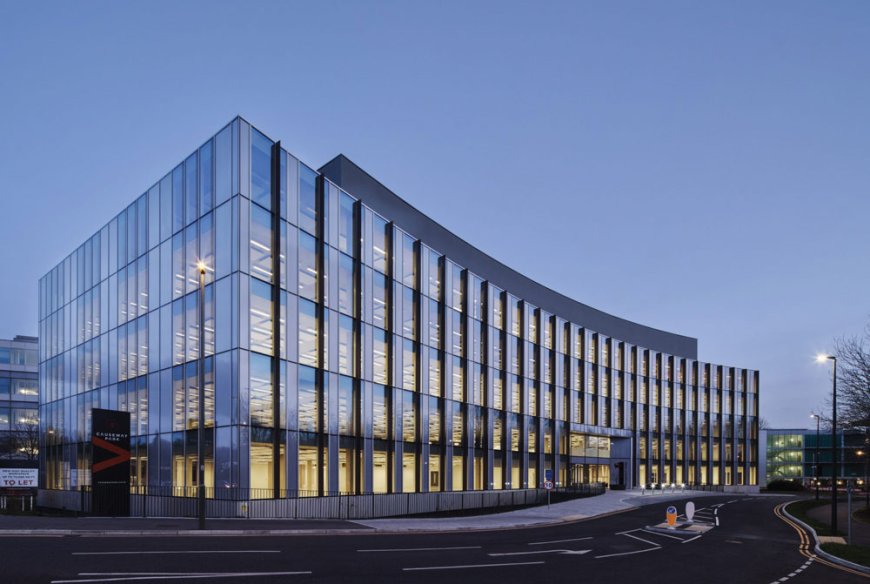ON A STEADY GROWTH

As Indian cities are transforming from paucity to possibilities, the commercial buildings market is expected to contribute to the Indian real estate market in a big way in the coming years. Construction Times explores the trend.
The Indian commercial real estate market has seen a steady growth, especially in the post-pandemic scenario. Entry of more global players into Indian market and expansion of existing Indian players in various industry segments have pushed the further growth of the Indian commercial real estate market. The developers and other stakeholders in commercial buildings and infrastructure sector see a positive trend in their business and look positive on the future.
Prevailing market scenario

In the commercial office space, the overall market activity has been boisterous, particularly in the last quarter of the year 2023, according Cushman & Wakefield. Anshul Jain, Managing Director, India & South East Asia and Head of APAC Tenant Representation, Cushman & Wakefield elaborates, “Net absorption (N.A.) of office space stood at 41 MSF, which was highly unexpected given that the YTD no. as of Q3 was recorded under 23 MSF. This is the second highest volume recorded after 2019, when the net absorption stood at ~43 MSF.” Large volume of fresh space taken-up by corporates drove leasing volume, which was led by Bengaluru (40% share in N.A.), followed by Hyderabad and Mumbai. From a supply standpoint, about 18 MSF of new completions were recorded in Q4, resulting in ~48 MSF of new supply for the full year. A lot of new supply that came in during the year 2023 has reasonably good pre-commitments, thereby contributing to a positive net absorption or demand.
According to Jain, a similar robustness has been observed in the commercial retail space, with close to 6.0 MSF of malls commencing operations in 2023, the biggest supply additions recorded in the post-Covid period. This is owing to nearly two years of heightened activity in retail demand across malls and main streets.
According the market research firm ANAROCK, the first half of fiscal year 2024 has been a relatively tepid period for the commercial office space activity across the top 7 cities with both net absorption and new completions remaining mostly stagnant as compared to same period last year. The silver lining is that despite all domestic challenges and global headwinds including layoffs early on, office activity remained more or less same in first half of FY 2024 as compared to corresponding period in FY 2023. It was widely anticipated that commercial demand will see a downturn in India amid layoffs by several large corporates and shrinking businesses.

As per data, in the first half of the fiscal year 2024, the Indian office market witnessed a 5% surge in fresh office supply across the top 7 cities, amounting to nearly 25.12 mn sf. Bappaditya Basu, Chief Business Officer, ANAROCK Commercial, elaborates, “Among the cities, the southern cities (Bengaluru, Hyderabad, and Chennai) continued to dominate in H1 FY24, collectively comprising 72% share of the total new office supply across the top 7 cities.
As for net office absorption, demand for office spaces in the top 7 cities underwent a marginal yearly decline of one per cent in H1 FY2024, amounting to nearly 18.84 mn sf total area. Of this, Bengaluru remained on top comprising 24% share of the net office absorption across the top 7 cities.”

The Indian commercial real estate market, characterized by partial fragmentation and high competitiveness, is gaining traction among global institutional investors. According to Bhavik Bhandari, CSMO, Ashwin Sheth Group, the stable growth and resilience of the Indian office space market in 2023 reflects a promising outlook for the year ahead. “Factors such as technology integration, policy support, and a focus on sustainability are shaping the future of the real estate industry. Navigating these waves of change requires strategic adaptation and a forward-thinking approach to ensure sustained growth and success,” he adds.
A noteworthy trend in the Indian office space market is the growing influence of domestic occupiers, who accounted for nearly 50% of total office space occupancy in 2023. “Flex spaces thrived in particular as occupiers increasingly favoured flexible and adaptable working arrangements for their office portfolios. As India's commercial real estate market undergoes transformative changes, the traditional office model is giving way to the rising popularity of flex workspaces. Another trend we have seen is fractional ownership and it is booming in India,” says Bhandari.

According to Sarveshaa S B, Chairman & Managing Director, BHADRA Group, the commercial real estate scene in India is booming, especially in tech-driven Bengaluru, and is set to hit $106 billion by 2029. “Bengaluru’s devouring office space is attracting IT giants. Beyond Bengaluru, the sector is bouncing back from the pandemic, with companies returning to quality spaces that suit their needs. There's a shift towards superior-grade assets, giving companies a chance to create excellent, sustainable spaces.”
Metro cities vis-à-vis non-metro cities
India's commercial real estate sector is going strong against global trends. According to Sarveshaa, Bengaluru is the star of the show, breaking records for absorbing office space and attracting big tech companies. In the world of offices, flexibility is the name of the game, with co-working spaces and flexible leases taking the spotlight. “Smaller cities, like Tier 2 ones, are becoming attractive for businesses because of their growing talent. Retail is making a comeback with a digital twist. Malls are turning into lively places where online shopping and in-person experiences come together, creating cool experiences for customers. Mixed-use developments, a growing trend, offer a great setup for both businesses and residents across cities,” he adds. BHADRA Group is right in the middle of this exciting scene and will be launching its first residential and commercial space that is all about innovation and excellence.
According to the emerging trends, tier-2 and tier-3 cities are seeing better opportunities for commercial buildings due to improved connectivity and affordability compared to metro cities. Basu says, “Considering the growing opportunities in many of the tier 2 & 3 cities including several infra projects in the pipeline, relatively affordable prices and growing interest of their workforce, few large corporates saw it an opportune time to expand their base there. This ultimately led to the rise of a significant trend – flexi spaces vying for spaces in many of the tier 2 & 3 cities over the last one year. Among the prominent cities include Lucknow, Jaipur, Chandigarh, Bhubaneshwar, Indore, Vizag, Coimbatore, and Ahmedabad among others.”
Likewise, demand for flexible office spaces in top 7 cities also hit a new high post the pandemic, with major companies and businesses including start-ups now opting for co-working spaces, according to Basu. “Of net absorption across the top cities, we saw its share increase to 23% in FY23 as against 11% back in FY2019 and further to 24% in H1 FY2024. In the last five years, its share was the lowest in FY21, largely owing to work-from-home amidst covid-infused lockdowns in the period. But with offices resuming, its demand has hit a new peak,” he adds.
According to Jain, several tier-II cities are joining the bandwagon as many local and national developers are bringing in the necessary Grade-A quality supply required by IT-ITES and other corporations.
Market outlook
According to Sarveshaa, India's booming economy is fuelling a growing need for more offices and retail spaces, especially in smaller cities that are gaining popularity for development. “Sustainability is taking centre stage, with a focus on eco-friendly buildings and energy-efficient designs gaining traction. Simultaneously, technology is playing a pivotal role in shaping the landscape, introducing innovations like smart buildings and digital features to enhance efficiency,” he adds.
The Indian economy is in a better position than most of its western counterparts, but there is uncertainty about the future. Basu says, “In 2023, we also saw a few large leasing decisions by corporates slowdown over the year. This cast a shadow on the leasing activity and thus the current challenging scenario in Indian office market could continue till the first half of 2024 as many IT/ITeS companies have scaled down their business and are not looking to expand. However, these appear to be short-term challenges for the commercial office space demand amid these global headwinds, but we believe that the medium-to-long-term scenario remains positive for the Indian offices considering that good quality Grade A offices are still available at sub-dollar rentals. We expect some stability in the office market largely from the second half of 2024.”
According to Bhandari, 2024 will also observe an ascent of smart buildings, with a projected CAGR of 20%, underlining the sector’s commitment to integrating advanced technologies for enhanced sustainability and building efficiency. “Investors and occupiers alike thus anticipate a paradigm shift towards environmentally conscious real estate offerings,” he observes and adds further, “We at Ashwin Sheth Group are aggressively expanding and in the year 2024, we will be launching our signature commercial project in the central and western regions of MMR.”
Looking at the future plans of the Group, Sarveshaa highlights, “At BHADRA Group, our strategy is clear: to create modern and sustainable spaces infused with cutting-edge technology. We are not confining ourselves to only Bengaluru but will be expanding into more cities, recognising the potential they hold for growth. Collaborative partnerships are at the core of our approach, seeking alliances to bring in expertise and resources for mutual benefit. Above all, our emphasis lies on making our spaces not just functional but places where people thrive.”
Jain is bullish on the future of India’s commercial real estate market, as he says, “The Indian real estate sector has done exceedingly well over the last two years, and we strongly believe that the current market momentum is likely to continue over the next decade. The commercial real estate sector will mirror India’s strong growth trajectory fuelled by a vibrant economy, controlled inflation, availability of a vast talent pool, across all asset classes.” According to him, in terms of office, India is likely to take a dominant role in the entire APAC region with highest amount of supply and absorption of Grade-A office space expected over the next couple of years. In the retail sector, close to 8.0 MSF of new supply is anticipated in 2024, thereby providing attractive proposition to retailers who are planning to expand stores or those making debut into India.
“Today, Indian commercial real estate is full of possibilities—embrace changes confidently for success in this ever-evolving landscape,” Sarveshaa concludes on a positive note.







